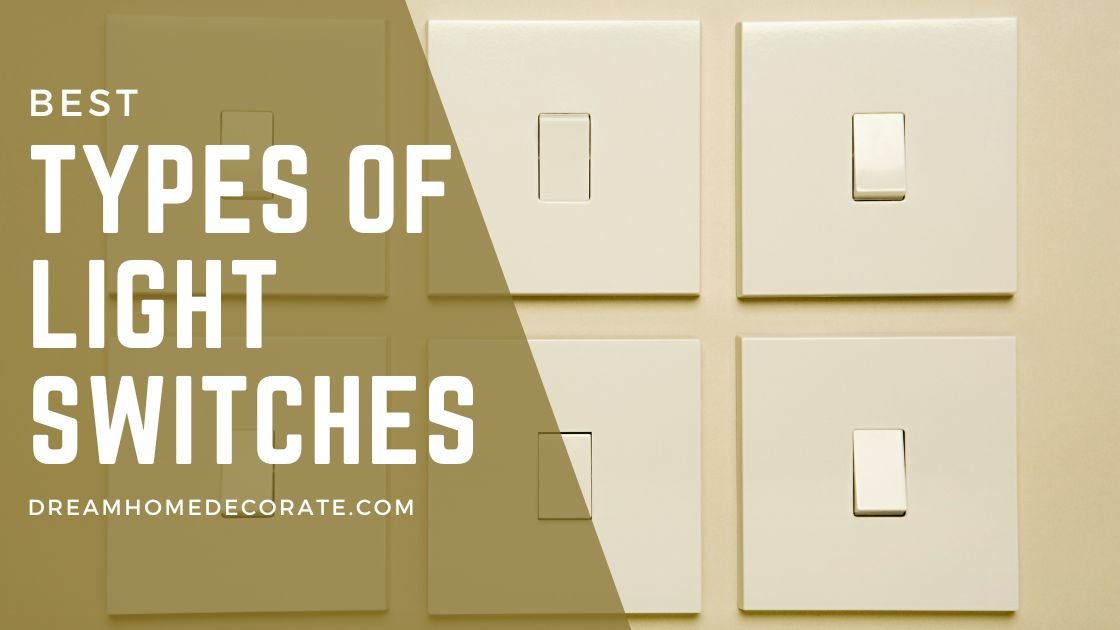Looking for different types of light switches? Do you wish to light up a room at home or the office? Then it sounds like you may need to learn first about the different types of light switches. The lighting certainly is an integral part of enriching the look of your home. The reason why today we’ll be telling you about different types of light switches.
Some light switches incorporate unique features, like motion detectors, to make moving around in your home safer and more convenient. Choosing the correct type of light switches for your homes and offices can be overwhelming. The different styles, materials, and features can be daunting to choose from. That’s why it is always a good idea to do some research beforehand.
And with so many options, it can become challenging to make the right choice. So we are here to help and point you in the right direction by showing different light switches for all your lighting needs.
Types of Light Switches
Decorator Paddle Rocker Light Switch
Durable construction made of high-quality, impact-resistant polycarbonate thermoplastic and solid steel.
Modern decorator-style switch for residential use in houses, condos, apartments and most commercial areas that require only 15A switches such as offices, schools, stores, shops, restaurants, public facilities, and hotels.
This wall switch is made from high-quality Polycarbonate Thermoplastic material for long-lasting durability and the switch features a shallow body design that will fit any standard wall box.
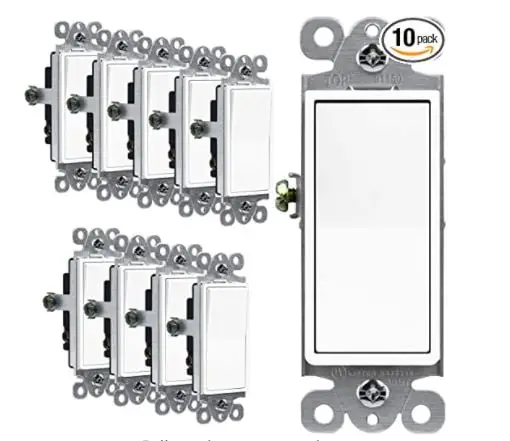
Features:
- 120 Volts
- Rocker style
- Alloy Steel, Plastic
Light Switch with Wallplate
A positive, yet smooth and quiet On/Off paddle action allows you to feel the quality in which every switch is made. The modern look of a décor switch can enhance the style of anywhere a switch is needed.
Terminal screws accept up to 12AWG and quick push-in wiring only accepts 14AWG solid copper wire.
Full-rated current capacity with LED, tungsten, fluorescent or resistive loads. Motor capacity is 80% of switch rating.
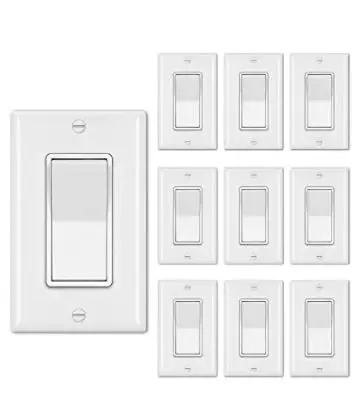
Features:
- Wall Mount
- Plastic
- Rocker-GFCI
Smart Light Switch
Turn electronics on and off from anywhere with your smartphone using the Kasa app, whether you are at home, in the office or on vacation.
Enjoy the hands-free convenience of controlling the lights in your home with your voice via Amazon Alexa or Google Assistant; perfect for times when your hands are full or entering a dark room.
Use timer or countdown schedule to set your smart switch to automatically turn on and off while you’re home or away. Enable ‘away mode’ to randomly switch on and off to trick potential intruders.

Features:
- Scheduling
- Voice control
- SPST
- Single pole
AC Quiet Switch Residential Grade
The 56042E rocker switch in black can be wired with tungsten, fluorescent and resistive loads, making it incredibly versatile.
This switch would look great in any home or office because its low profile design flows with your walls, keeping it from standing out to the eye. You can transform the look of your home and increase its resale value with these modern switches.
With the ease of the Quick-wire you need to do nothing more than push the wire into the rear of the switch and a spring action will automatically clamp the wire and insure a good electrical connection.
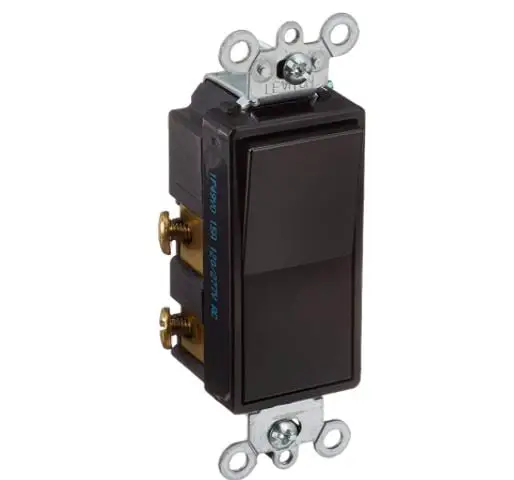
Features:
- 4-way switch
- Rocker style
- Sturdy construction
Wemo WiFi Light Switch
The Wemo Smart Light Switch uses your existing home WiFi network to provide wireless control of your lights from anywhere in the world.
No subscription or hub is required: simply replace your single-pole or 3-way switch with Wemo Light Switch and start controlling your lights from the wall, App, or with your voice using Amazon Alexa, Siri, or the Google Assistant.
Using the free Wemo App, you can set worry-free schedules and switch lights on and off no matter where you are.
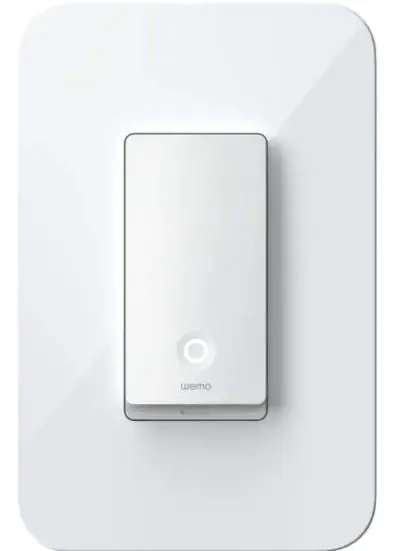
Features:
- Rocker Switch
- SPST
- 3-way
- Wall mount
- Push button
Common Questions About Types of Light Switches
What are the 4 Types of Light Switches?
SPST (Single Pole Single throw)
The SPST is a primary ON/OFF switch used to connect or break the connection between two terminals. The power supply for the owl circuit is given by this switch.
SPDT (single pole double throw)
The SPDT switch is a three-terminal switch; one terminal is used as input, and the remaining two terminals are used as outputs. It joins a mutual terminal to one or the other of two terminals. In the SPDT switch, instead of different terminals, use the COM terminal. For example, we can use COM & A or COM & B.
DPST (double pole, single throw)
The DPST switch consists of two poles that mean it includes two identical buttons located side by side. This switch is operated by one single toggle, which means that two discrete circuits are controlled at a time through one push.
DPDT (double pole double throw)
This switch is equal to two SPDT switches; it means two separate circuits, connecting two inputs of each circuit to one of two outputs. The switch position controls the number of ways and from the two contacts.
What are the five types of switches?
These are the five most common wall switches you use in your home and elsewhere.
Single-Pole Switch
The single-pole switch is the general-purpose workhorse of switches. It is used to control a light, receptacle, or another device from a single location. Its characteristic on/off markings on the toggle isn’t found on other switches.
Three-Way Switch
Three-way switches are used in pairs and usually found at both ends of a staircase or in garages or basements with two entries, hallways, and other places where two separate switches control one light.
Double-Pole Switch
The double-pole switch is commonly used in industrial applications but can be found in some home wiring systems. Double-pole switches are typically rated 30 amps, compared to 15 amps or 20 amps with standard buttons. This allows the switches to control power feeding higher-demand appliances, motors, and machinery.
Four-Way Switch
The four-way switch is used between two three-way switches to control an outlet or light fixture from multiple locations. The four-way switch looks similar to a double-pole switch but without markings. It has four terminals plus a ground terminal.
Smart Switch
The smart switch is the newest type of switch that’s becoming more popular because of its convenience. The switch allows you to control your lights from anywhere in the house, even from bed.
What kind of switch do I need for a light switch?
Select a type of light switch that is compatible with the circuit where it will be installed. For example, if a light is controlled by one switch, you’ll need to replace it with a single-pole switch. Toggle: A toggle light switch is the most common style. It has a single toggle that sticks out from the faceplate.
What are the light switches styles?
- Toggle: A toggle light switch is the most common style. It has a single toggle that sticks out from the faceplate. The toggle is switched up or down to turn the light on or off.
- Rocker: A rocker light switch operates similarly to a toggle switch, but the design differs. It is wider and flatter than the toggle switch. It also requires less pressure to operate, making it a good switch style for accessibility.
- Push-Button: The push-button light switch style is an older design than the toggle switch, but enjoys resurgences of popularity from time to time.
- Touch Light: The touch light switch relies on capacitance to operate. Touching the surface alters the electrical field between the touchpad outer surface and the inner surface which causes the light to trigger.
What aspect should you keep in mind when buying a light switch?
- Timer. Allows you to program activation time. Provides security while out of town or returning home after dark.
- Motion Sensor. Activates lights when motion is detected in a room and turns off lights automatically. Offers convenience of a no-touch lighting system and may help save on energy costs.
- Switch/Receptacle Combo. Combines a switch and an outlet in one. Ideal for locations where additional outlets are needed.
- Time-Delay. Allows power to flow to a fixture for a set amount of time. Shuts off automatically when set time has elapsed.
What is another alternative to light switches?
The most common household switch, a single-pole, has two terminals and simply turns power on or off. A dimmer switch controls a light’s intensity. You can usually replace any single-pole switch with a dimmer.

